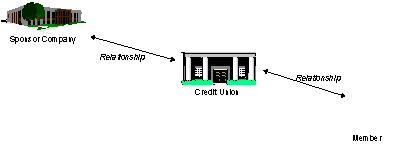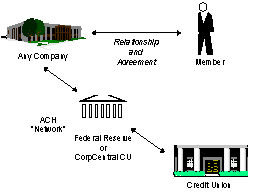Helpful Resources
Available ACH Transaction Options
SEE ALSO: Understanding ACH - Overview and Terminology
SEE ALSO: Understanding Payroll Deduction
ACH vs. Payroll Deduction
The Automated Clearing House (ACH) and CU*BASE Payroll Deduction are two very different tools, that at first glance may not seem related. However, because they can both be used to receive payroll deposits for your members, they are very often confused. The purpose of this section is to describe and clarify the similarities and differences between the two systems.
One of the most powerful forces in the early days of the credit union movement was that the unique relationship between a company and its credit union gave the company a way to deposit payroll funds directly into their employee's accounts. Employers and employees alike enjoyed the convenience and savings offered by this arrangement, and credit unions were able to establish a unique “niche” in the financial services industry.
By definition, then, Payroll Deduction requires that a credit union establish a relationship with a company for the purpose of sending payroll funds directly to credit union members.

Then along came the Automated Clearing House (ACH). Besides revolutionizing the way many different types of financial transactions are conducted, it provided a new way for employers to transmit payroll directly to their employees' financial institutions. Credit unions could offer “direct deposit,” as well as many other types of transactions, for any member, whether or not that member worked for a sponsoring company.
With ACH, the credit union receives transactions for member accounts through the ACH network, via the Federal Reserve Bank or Corporate Central Credit Union. Transactions can come from any company or organization with which the member has an agreement to send or receive funds. Because ACH acts as the “middleman” for all incoming and outgoing transactions, the credit union does not necessarily need to have any relationship with the originating company.

Comparing ACH and Payroll Deduction
|
ACH |
Payroll Deduction |
|
Does not require a relationship with the originating company; transactions can come from any source. |
Requires a relationship and agreement with an organization that sends payroll information to the credit union. |
|
Can include transactions of any type (debits or credits), for any purpose (depositing a paycheck, making a loan payment, paying an insurance premium or utility bill, receiving a government check, etc.). |
Can be used to deposit payroll funds only. |
|
CU*BASE interface allows for transfer of funds between credit union accounts. |
CU*BASE interface allows for transfer of funds between credit union accounts. |
|
Does not require manual account balancing; only what is transmitted is posted. |
Requires balancing against a payroll file on CU*BASE to ensure that all funds received are posted to member accounts properly, and that what is posted equals funds received. |
|
Returns and modifications done through ACH transmissions. |
Returns and modifications are coordinated between credit union and company. |
|
Transmissions of transactions are electronic. |
Transmission of payroll can be via any method agreed upon between the company and the credit union (printed list, magnetic tape, diskette, etc.). |
|
Posting happens in the morning (credits) and evening (debits). Timing of posting is not under the credit union's control (except for self-processing credit unions). |
Timing of posting is controlled by the credit union. |
Because more and more companies are electing to use the convenience of ACH for payroll and other financial transactions, credit unions may use both systems to handle their member's financial needs. In most cases, the member is not even aware of which system is used—they just appreciate the convenience of having their paycheck deposited directly into their account!